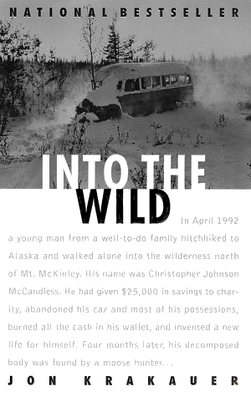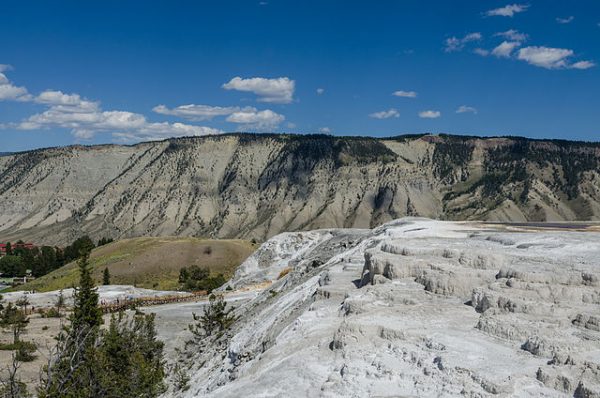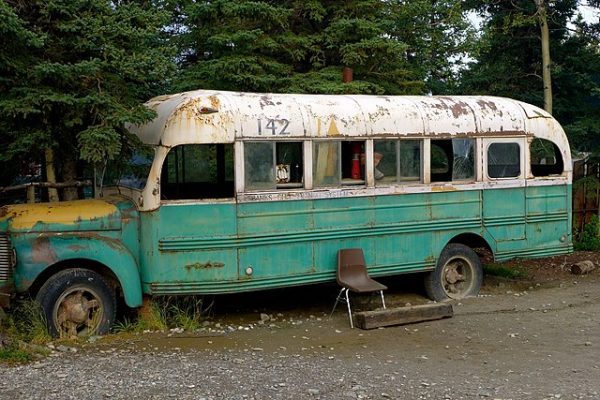
Into the Wild: A Modern Wilderness Narrative
In 1992, Chris McCandless walked into the Alaskan wilderness seeking the sublime power of nature, and ultimately became immortalized for his tragic devotion. Jon Krakauer’s bestselling novel, Into the Wild, recounted McCandless’ nomadic journey until it untimely ended with his death [1]. Since publication, readers have been fascinated with this story, which echoes an Americanized cultural idea about the natural world: Nature, understood as vast expanses of public land, is valuable because it inspires self-improvement, generally among white men.
A retelling of the “Man Versus Wilderness” narrative for the new millennium, Into the Wild furthers the historically white American understanding that humans are divorced from the natural world. The book’s influence has become problematic, as it has created unrealistic public expectations for outdoor experiences that conflict with the priorities of public lands managers.
Separating People from Their Environments
The story of a young man pitting himself against unforgiving terrain is tangled in the American imagination with the notions of westward expansion and white supremacy, which both separate individuals from their environments. Ideas about the division between humans and nature particularly resonated with empowered white men like John Muir and Theodore Roosevelt, who developed the American Conservation Movement in the late 19th century.
To create and protect a system of “natural” parks, the prevailing wisdom that came from the American Conservation Movement stated that the land’s human population had to be removed [2]. The establishment of Yellowstone National Park in 1872 coincided with the expulsion of the park’s Indigenous inhabitants [3]. 1870’s Yellowstone resembled a western military installation in order to protect the park from what park officials called “Indian depredations,” referring to the Indigenous habitation [4].

Over 10 tribes used the park as a seasonal settlement during the 19th century alone [5]. Ultimately, it was the Nez Perce Tribe who evaded the U.S. military in a weeks-long chase across the park in 1877 [6]. The tribe was removed from Yellowstone and forced to subside to what is now the Nez Perce Reservation in 1893, where descendants of the tribe still reside [7].
As more American settlers sought out the West’s scenic landscapes during the 1900s and 1910s, the “appreciation of wilderness … spread from a relatively small group of Romantic and patriotic literati, to become a national cult,” according to historian Roderick Nash [8]. With this growing appreciation of uninhabited scenery, lawmakers enshrined the division between humans and nature in federal law. The 1964 Wilderness Act defined wilderness as lands “where man himself is a visitor who does not remain” [9]. This exclusionary definition didn’t recognize how both nature and history are dynamic systems [10].
Informally, this idea also shaped the cultural expectations of how people should recreate in pristine landscapes, which were becoming difficult and expensive to access. The “Leave No Trace,” slogan introduced a set of practices and ethics that emerged in 1983 that supported people who were passionate about preserving the land that they enjoyed by allowing the public to visit natural areas without damaging them [11]. Much like McCandless, wilderness users like backpackers and hikers departed from their normal lives and sought out personally fulfilling experiences within natural places that they imagined separate from human influence.
The Enduring Legacy of Man Vs. Wild
Into the Wild painted an empathetic portrait of McCandless’ pilgrimage and created new challenges for public lands managers. As a young man disillusioned with modern society, McCandless donated his life savings to charity after graduating from college and headed west seeking a sense of purpose, and answers to his existential questions [12]. Eventually reaching Alaska, McCandless camped out in an abandoned bus outside of Denali National Park left by a construction crew in the 1960s [13].
Krakauer’s romantic portrayal of McCandless’s life as a modern-day Henry Thoreau inspired thousands of readers to visit the so-called “Magic Bus” [14]. The bus lies at the end of a 26-mile hike from the Alaskan Highway [15]. After several tourists looking for the required rescue, and a handful died in their attempts, the Alaskan National Guard relocated the bus to the University of Alaska’s Museum of the North [16]. In their attempts to create similar experiences for themselves on the supposed far side of the nature-culture divide, visitors frequently place themselves, rescuers, and the land’s resources at risk.

Into the Wild retells the “man versus wilderness” narrative in a way that reduces public lands to conduits for individual self-discovery. As PLHC director and history professor Dr. Jared Orsi notes, “we are the inheritors of past imaginations that shaped landscapes and limit what we can do today … but if we want spaces to truly serve a broad swath of the American populace, we need to acknowledge the narrowness of the wilderness concept and expand it” [17]. Perhaps because people are drawn to the themes of anti-modernism and romanticized wilderness, public lands are reduced to mythologized conduits for self-discovery that purport not to have human histories.
Although Krakauer’s narrative positions McCandless as a modern follower of Thoreau who railed against the evils of modern society, ultimately, his use of public lands as a proving ground to demonstrate his own strengths reflects a modern and exclusionary understanding of nature [18].
Conclusion
McCandless’ tragic story is the latest version of a centuries-old tale that separates people from their surroundings, and it will not be the last. As this narrative is inextricably tied with whiteness and class, it may not be able to challenge how people conceptualize nature. But can our collective conceptual understanding of the environment ever change if individuals like McCandless no longer retain the same romanticism?
The value of public lands and natural space can be better understood within a framework that places humans within the natural world — something that Indigenous peoples have long understood. While this conversation is taking place among scholars and public lands managers with the appointments of Deb Haaland as Secretary of the Interior and Charles Sams as the Director of the National Park Service, it has not yet emerged in popular discourse [19]. Perhaps this public conversation will come with a blockbuster literary work that challenges the nature-culture divide, rather than mythologizing it.
— Corinne Neustadter, 2021 PLHC Intern
Sources
[1] Krakauer, Jon. Into the Wild. Somerville, MA: Candlewick Press, 2010.
[2] “Yellowstone National Park (U.S. National Park Service).” National Parks Service. U.S. Department of the Interior. Accessed 2021. https://www.nps.gov/yell/index.htm.
[3] 42nd Congress, 2nd Session. “A Century of Lawmaking.” A century of lawmaking for a new nation: U.S. congressional documents and debates, 1774 – 1875. Accessed 2021. https://memory.loc.gov/cgi-bin/ampage?collId=llsl&fileName=017%2Fllsl017.db&recNum=73.
[4] Spence, Mark David. Essay. In Dispossessing the Wilderness: Indian Removal and the Making of the National Parks, 85–86. Oxford: Oxford University Press, 2000.
[5] Magazine, Smithsonian. “The Lost History of Yellowstone.” Smithsonian.com. Smithsonian Institution, January 1, 2021. https://www.smithsonianmag.com/history/lost-history-yellowstone-180976518/.
[6] Spence, Mark David. Essay. In Dispossessing the Wilderness: Indian Removal and the Making of the National Parks, 87–88. Oxford: Oxford University Press, 2000.
[7] “History.” Nez Perce Tribe. Accessed 2021. https://nezperce.org/about/history/.
[8] Roderick Nash, Wilderness and the American Mind, 143.New Haven, CT: Yale University, 1967.
[9] “Wilderness Connect.” Wilderness Connect – University of Montana. Accessed 2021. https://wilderness.net/learn-about-wilderness/key-laws/wilderness-act/default.php.
[10] Neustadter, Corinne. Conversation with Dr. Childers. Personal, November 10, 2021.
[11] Turner, James Morton. “Wilderness, Consumerism, and Environmentalism in Twentieth Century America.” Essay. In From Woodcraft to Leave No Trace, 462. Accessed 2021. http://faculty.washington.edu/timbillo/Readings%20and%20documents/Wilderness/Turner% %20Woodcraft%20to%20LNT.pdf.
[12] Krakauer, Jon. In Into the Wild, 20-21. Somerville, MA: Candlewick Press, 2010.
[13] Krakauer, Jon. In Into the Wild, 18. Somerville, MA: Candlewick Press, 2010.
[14] Saverin, Diana, Eva Holland, Adam Roy, and Jonathan Olivier. “The Chris Mccandless Obsession Problem.” Outside Online, June 30, 2021. https://www.outsideonline.com/adventure-travel/destinations/north-america/chris-mccandless-obsession-problem/.
[15] Google Maps. “George Parks Hwy Parking.” n.d. Map. The Magic Bus, 1962 Yukon Dr, Fairbanks, AK 99775.
[16] Daleo, Jack. “Here’s What’s Happening to the into the Wild Bus.” Backpacker, July 22, 2021. https://www.backpacker.com/news-and-events/heres-whats-happening-to-the-into-the-wild-bus/.
[17] Neustadter, Corinne. Conversation with Dr. Jared Orsi. Personal, November 10, 2021.
[18] Krakauer, Jon. Into the Wild, 56. Somerville, MA: Candlewick Press, 2010.
[19] Gonzalez, Oriana. “Senate Confirms Charles Sams III as First Native American to Head National Park Service.” Axios, November 20, 2021. https://www.axios.com/charles-sams-first-native american-national-parks-e3b19396-3e54-47da-a353-a9c15b398dc4.html.